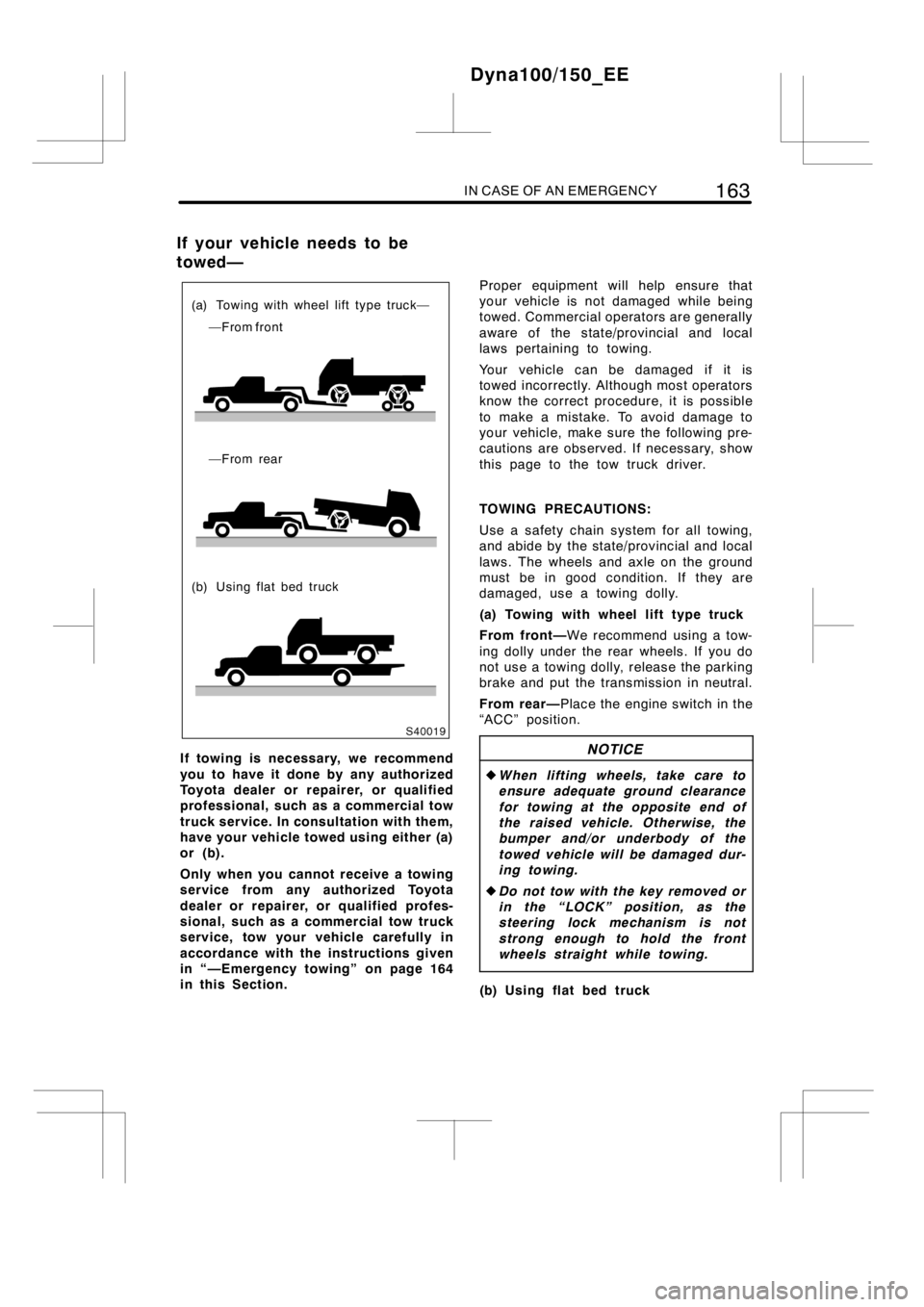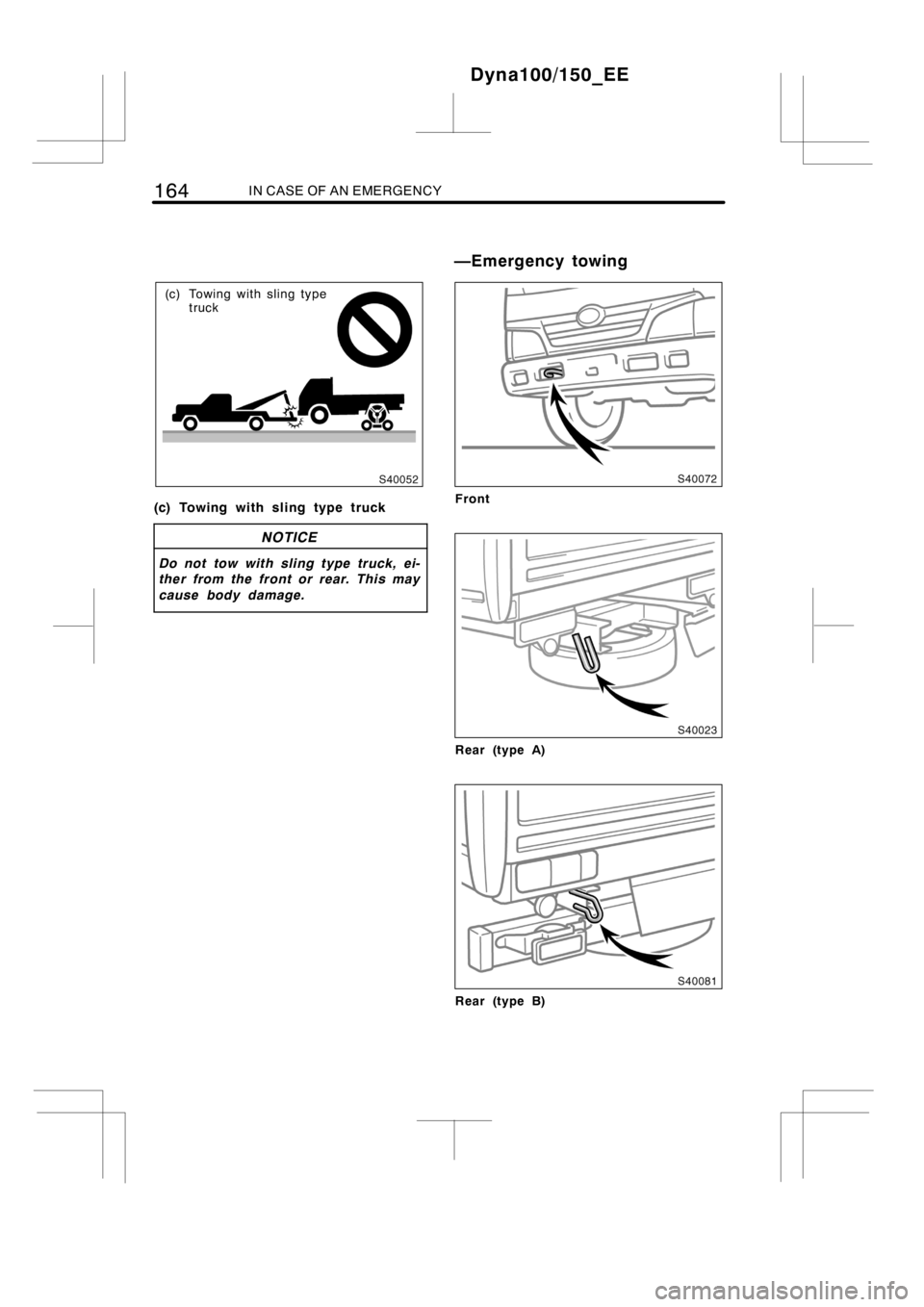2014 TOYOTA DYNA 100/150 emergency towing
[x] Cancel search: emergency towingPage 149 of 232

IN CASE OF AN EMERGENCY143
To avoid serious injury and damage to
your vehicle which might result from
battery explosion, acid burns, electrical
burns, or damaged electronic compo-
nents, these instructions must be fol-
lowed precisely.
If you are unsure about how to follow this
procedure, we strongly recommend that
you seek the help of a competent me-
chanic or towing service.
CAUTION
DBatteries contain sulfuric acid
which is poisonous and corrosive.
Wear protective safety glasses when
jump starting, and avoid spilling
acid on your skin, clothing, or ve-
hicle.
DIf you should accidentally get acid
on yourself or in your eyes, remove
any contaminated clothing and flush
the affected area with water imme-
diately. Then get immediate medical
attention. If possible, continue to
apply water with a sponge or cloth
while en route to the medical office.
DThe gas normally produced by a
battery will explode if a flame or
spark is brought near. Use only
standardized jumper cables and do
not smoke or light a match while
jump starting.
NOTICE
The battery used for boosting must
be 12 V. Do not jump start unless you
are sure that the booster battery is
correct.
JUMP STARTING PROCEDURE
1. If your vehicle is equipped with the
battery cover, remove it.
2. If the booster battery is installed in
another vehicle, make sure the vehicles
are not touching. Turn off all unneces-
sary lights and accessories.
When boosting, use the battery of
matching or higher quality. Any other
battery may be difficult to jump start
with.
If jump starting is difficult, charge the
battery for several minutes.
3. If the engine in the vehicle with the
booster battery is not running, start it
and let it run for a few minutes. During
jump starting, run the engine at about
2000 rpm with the accelerator pedal
lightly depressed.
Dyna100/150_EE
(c) Jump starting
Page 169 of 232

IN CASE OF AN EMERGENCY163
(a) Towing with wheel lift type truck—
—From front
—From rear
(b) Using flat bed truck
If towing is necessary, we recommend
you to have it done by any authorized
Toyota dealer or repairer, or qualified
professional, such as a commercial tow
truck service. In consultation with them,
have your vehicle towed using either (a)
or (b).
Only when you cannot receive a towing
service from any authorized Toyota
dealer or repairer, or qualified profes-
sional, such as a commercial tow truck
service, tow your vehicle carefully in
accordance with the instructions given
in “—Emergency towing” on page 164
in this Section.Proper equipment will help ensure that
your vehicle is not damaged while being
towed. Commercial operators are generally
aware of the state/provincial and local
laws pertaining to towing.
Your vehicle can be damaged if it is
towed incorrectly. Although most operators
know the correct procedure, it is possible
to make a mistake. To avoid damage to
your vehicle, make sure the following pre-
cautions are observed. If necessary, show
this page to the tow truck driver.
TOWING PRECAUTIONS:
Use a safety chain system for all towing,
and abide by the state/provincial and local
laws. The wheels and axle on the ground
must be in good condition. If they are
damaged, use a towing dolly.
(a) Towing with wheel lift type truck
From front—We recommend using a tow-
ing dolly under the rear wheels. If you do
not use a towing dolly, release the parking
brake and put the transmission in neutral.
From rear—Place the engine switch in the
“ACC” position.NOTICE
zWhen lifting wheels, take care to
ensure adequate ground clearance
for towing at the opposite end of
the raised vehicle. Otherwise, the
bumper and/or underbody of the
towed vehicle will be damaged dur-
ing towing.
zDo not tow with the key removed or
in the “LOCK” position, as the
steering lock mechanism is not
strong enough to hold the front
wheels straight while towing.
(b) Using flat bed truck
Dyna100/150_EE
If your vehicle needs to be
towed—
Page 170 of 232

164IN CASE OF AN EMERGENCY
(c) Towing with sling type
truck
(c) Towing with sling type truck
NOTICE
Do not tow with sling type truck, ei-
ther from the front or rear. This may
cause body damage.
Front
Rear (type A)
Rear (type B)
Dyna100/150_EE
—Emergency towing
Page 171 of 232

IN CASE OF AN EMERGENCY165
If towing is necessary, we recommend
you to have it done by any authorized
Toyota dealer or repairer, or qualified
professional, such as a commercial tow
truck service.
If towing service is not available in an
emergency, your vehicle may be tempo-
rarily towed by a cable or chain se-
cured to one of the following parts:
Front: Front emergency towing hook
Rear: Rear emergency towing eyelet
Use extreme caution when towing the
vehicle.
NOTICE
Only use specified towing hook or
eyelet; otherwise your vehicle may be
damaged.
A driver must be in the vehicle to steer
it and operate the brakes.
Towing in this manner may be done only
on hard−surfaced roads for a short dis-
tance and at low speeds. Also, the
wheels, axles, drive train, steering and
brakes must all be in good condition.
CAUTION
Use extreme caution when towing the
vehicle. Avoid sudden starts or errat-
ic driving maneuvers which would
place excessive stress on the emer-
gency towing hook or eyelet and tow-
ing cable or chain. The hook or eye-
let and towing cable or chain may
break and cause serious injury or
damage.
NOTICE
Use only a cable or chain specifically
intended for use in towing vehicles.
Securely fasten the cable or chain to
the towing hook or eyelet provided.
Before towing, release the parking brake
and put the transmission in neutral. The
engine switch must be in “ACC” (engine
off) or “ON” (engine running) position.
CAUTION
If the engine is not running, the pow-
er assist for the brakes and steering
will not work so steering and braking
will be much harder than usual.
Dyna100/150_EE
Page 172 of 232

166IN CASE OF AN EMERGENCY
DBefore emergency towing, check that
the hook or eyelet is not broken or
damaged and that the installation bolts
are not loose.
DFasten the towing cable or chain se-
curely to the hook or eyelet.
DDo not jerk the hook or eyelet. Apply
steady and even force.
DTo avoid damaging the hook or eyelet,
do not pull from the side or at a verti-
cal angle. Always pull straight ahead.You can purchase a new key at any
authorized Toyota dealer or repairer, or
another duly qualified and equipped
professional, if you can give them the
key number.
See the suggestion given in “Keys” on
page 12 in Section 1−2.
If your key is locked in the vehicle and
you cannot get a duplicate, many autho-
rized Toyota dealers, repairers or other
duly qualified and equipped professionals
can still open the door for you, using their
special tools. If you must break a window
to get in, we suggest breaking the side
window because it is the least expensive
to replace. Be extremely cautious to avoid
cuts from the glass.
Dyna100/150_EE
—Emergency towing hook or
eyelet precautionsIf you lose your keys
Page 229 of 232

INDEX223
E
Economical driving
Saving money on both fuel and
repairs 138..........................
Electrical system
Access to the battery 182..............
Battery 200,202.......................
Fuse locations 182....................
Fuses 203............................
Emergency flasher switch 64.............
Emergency, In case of
Bleeding the fuelsystem 142...........
Blown fuse 203........................
Emergency flasher switch 64...........
Flat tire 149...........................
If you cannot increase engine
speed 147..........................
If you lose your keys 166...............
If your engine stalls while
driving 147..........................
If your vehicle becomes stuck 162......
If your vehicle has to be stopped in
an emergency 167...................
If your vehicle needs to be
towed 163...........................
If your vehicle will not start 142.........
Jump starting 143.....................
Overheating 148.......................
Towing 163............................
Engine
Access hole cover 17..................
Before starting the engine 124..........
Checking the coolant level 190.........
Engine compartment 180...............
Exhaust gas caution 114...............
Identification number 122..............
Oil consumption 115...................
Oil level 188...........................
Overheating 148.......................
Starting procedure 124.................
Turning off an engine with
turbocharger 126....................
Engine coolant
Temperature gauge 68.................
Winter driving tips 129.................
Engine coolant temperature gauge 68.....Engine oil
Oil maintenance management
system 70..........................
Winter driving tips 129.................
Engine oil change reminder light 73.......
Engine switch 80........................
Exhaust gas caution 114.................
F
Facts about engine oil
consumption 115......................
Flasher, Headlight 62....................
Flat tire
After changing wheels 162.............
If you have a flat tire 149...............
Installing wheel 159....................
Jack point 157.........................
Jacking precautions 149...............
Jacking up 157........................
Loosening wheel nuts 155..............
Lowering vehicle 160..................
Reinstalling wheel ornament 161........
Removing wheel ornament 155.........
Replacing inner rear wheel 158.........
Wheel block 154.......................
Floor mat 104...........................
Fluid level
Washer fluid 204......................
Fog light switch, Rear 64.................
Foreign countries, Operation in 110.......
Fuel
Bleeding the fuelsystem 142...........
Draining fuel filter water 192............
Fuel economy 138.....................
Gauge 68.............................
Operation in foreign countries 110......
Tank cap 21...........................
Fuel filter
Draining fuel filter water 192............
Fuel filter warning light 73................
Fuel information 108.....................
Fuse
Fuse box 203..........................
Fuse locations 182......................
Dyna100/150_EE
Page 232 of 232

226INDEX
Tires
Changing 149.........................
Checking and replacing 194............
Flat tire 149...........................
Inflation pressure 193,218..............
Replacing wheels 197..................
Rotating tires 195......................
Size 218..............................
Snow tires and chains 196..............
Spare 150............................
Tools 150...............................
To w i n g
Emergency towing 164.................
Emergency towing hook or
eyelet precautions 166...............
If your vehicle needs to be
towed 163...........................
Trailer 130............................
Trailer towing 130.......................
Trip meter 70............................
Turn signals 62..........................
V
Vehicle identification number 120.........
W
Warning buzzer 73......................
Warning light 73.........................
Washer fluid
Adding washer fluid 204................
Washing and waxing 171.................
Wheels
Replacing wheels 197..................
Windshield wiper and
washer switch 65......................
Winter driving tips 129...................
Dyna100/150_EE